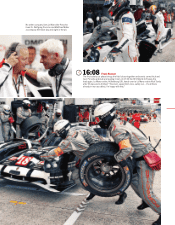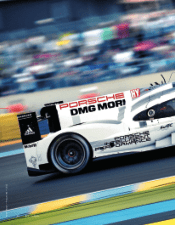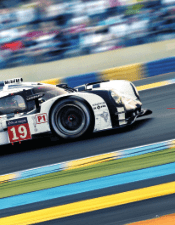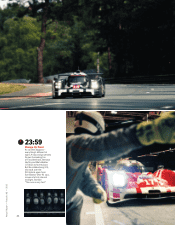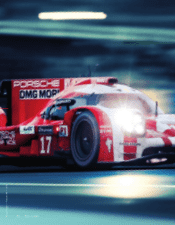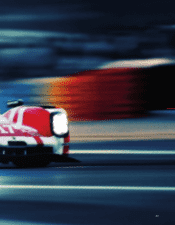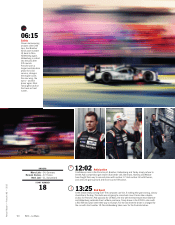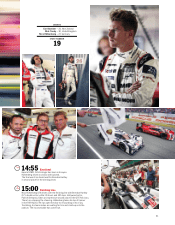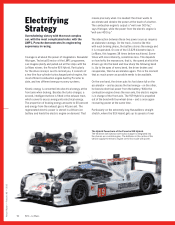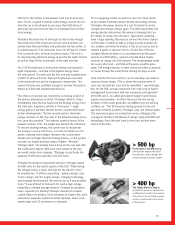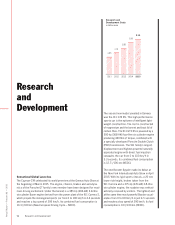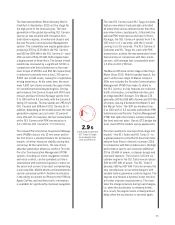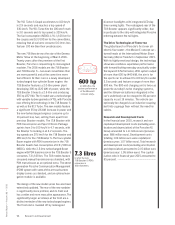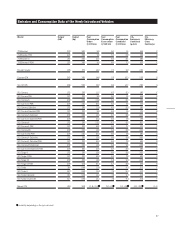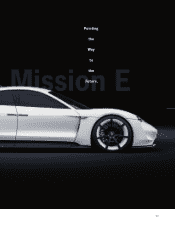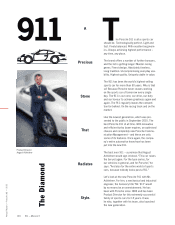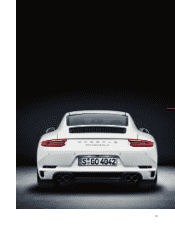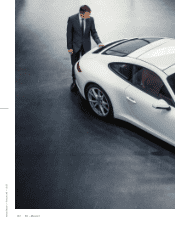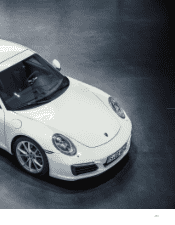Porsche 2015 Annual Report Download - page 97
Download and view the complete annual report
Please find page 97 of the 2015 Porsche annual report below. You can navigate through the pages in the report by either clicking on the pages listed below, or by using the keyword search tool below to find specific information within the annual report.
330 km/h, the turbine in the exhaust tract has to work very
hard. So far, so good. However, both energy sources are lim-
ited: the car is not allowed to use more than 4.65 litres of
petrol per lap and not more than 2.22 kilowatt-hours of elec-
trical energy.
Therefore the driver has to be frugal so that he has enough
fuel at the end of the round and not one drop has been con-
sumed more than permitted, and preferably not less either. It
is a balancing act: if he consumes more, he will pay for it later.
If he consumes less, he loses on performance. The trick is
tostop boosting electrical energy at exactly the right moment
as well as step off the accelerator at the right moment.
The 2.22 kilowatt-hours of electrical energy correspond to
eight megajoules – and that is the highest energy class
therules permit. Porsche was the first and only manufacturer
in 2015 to venture this far. Audi and Toyota were only able
todemonstrate four and six megajoules respectively. The
reason Porsche was confident enough to achieve this peak is
thanks to a bold and fundamental decision.
“The choice of concept was inspired by us looking at each of
the various alternatives in detail,” Hitzinger reflects. It was
immediately clear that we would use the braking energy from
the front axle. Engineers call this a “no-brainer” – large
energy gains on partially familiar terrain, coupled with major
further developments. “As the second system, the brake
energy recovery on the rear axle or the exhaust energy recov-
ery came into question.” Two aspects spoke in favour of the
exhaust solution. First, the weight and second, the efficiency.
“To recover braking energy, the system has to recuperate
theenergy in a very short time, so it has to handle a lot of
power, meaning more weight. However, the acceleration
phases are far longer than the braking phases, so the system
recovers for longer and that makes it lighter. “Besides”
Hitzinger adds, “we already have a drive on the rear axle with
the combustion engine. With even more power at the rear
wewould create more slippage. “Slippage is practically the
opposite of efficiency and also ruins the tyres.”
Probably the boldest fundamental decision: Hitzinger opted
for800 volts for the hybrid system of the 919. “Determining
the voltage level is a major decision for the electric drive,”
heemphasises; “it affects everything – battery design, elec-
tronics design, electric engine design, charging technology
and charging infrastructure. We went as far as it was possible
to go.” It was difficult to find parts for such a high voltage,
especially a suitable storage medium. Flywheel accumulator,
super capacitors or battery? Hitzinger decided on a liquid-
cooled lithium-ion battery. It has hundreds of single cells, each
enclosed in separate cylindrical metal capsules, seven centi-
metres high and 1.8 centimetres in diameter.
For a road-going model, as well as a race car, there needs
tobe a balance between power density and energy density.
Thehigher the power density of a cell, the faster it can be
charged and release energy again. The other parameter, the
energy density, determines the amount of energy that can
bestored. In racing, the cell must – figuratively speaking –
have a huge opening. Because as soon as the driver stamps
on the brake, it needs to take in a huge amount of power all
ofa sudden, and when he boosts, it has to act just as fast to
release it again. In layman’s terms, it’s like this: if the dis-
charged lithium-ion battery in a smartphone had the power
density of a 919 battery, it would only take about twenty
seconds to charge it to 100 percent. The disadvantage would
be: a very short call – and then all the juice would be gone
again. The energy density, in other words the battery capacity,
is crucial to keep the smartphone running for days on end.
If we transfer this to an electric car for everyday use, battery
capacity means range. “This is where the requirements of
race cars and electric cars for the road differ,” says Hitzinger,
“but, for the 919, we have advanced into in the area of hybrid
management to an extent that was previously unimaginable.”
In the MissionE, so-called permanent magnet synchronous
engines are provided – in effect these are the non-racing
brothers of the motor generator unit (MGU) from the winning
Le Mans car. “The 919 was the testing ground for the volt-
agelevel of hybrid systems,” Hitzinger says, not without pride.
This experience gave our production series colleagues the
courage to introduce the Mission E design study with 800-volt
technology. From the race track to the road: perfect team-
workà la Porsche.
> 500 hp
Performance and Eciency:
a V4-cylinder engine with direct
fuel injection, turbo charger and
exhaust energy recovery system
> 400 hp
The Single Electric Engine
provides its power on demand via
a differential on both front wheels.
The state-of-the-art battery power
centre is positioned in the centre
of the vehicle.
93


